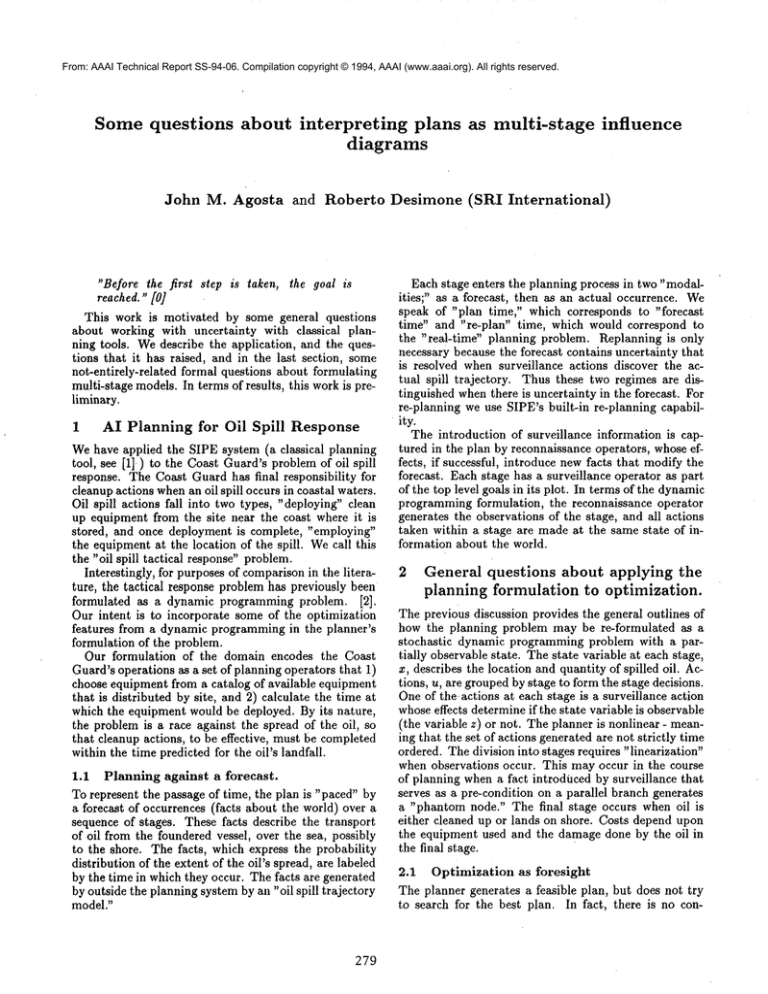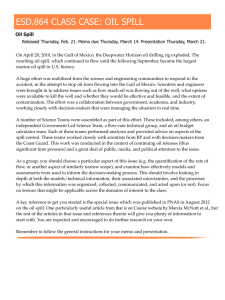
From: AAAI Technical Report SS-94-06. Compilation copyright © 1994, AAAI (www.aaai.org). All rights reserved.
Some questions
John
about interpreting
plans as multi-stage
diagrams
M. Agosta
and
Roberto
"Before the first step is taken, the goal is
reached." [0]
This work is motivated by some general questions
about working with uncertainty with classical planning tools. Wedescribe the application, and the questions that it has raised, and in the last section, some
not-entirely-related
formal questions about formulating
multi-stage models. In terms of results, this work is preliminary.
1
AI Planning for Oil Spill Response
Wehave applied the SIPE system (a classical planning
tool, see [1] ) to the Coast Guard’s problem of oil spill
response. The Coast Guard has final responsibility for
cleanup actions whenan oil spill occurs in coastal waters.
Oil spill actions fall into two types, "deploying" clean
up equipment from the site near the coast where it is
stored, and once deployment is complete, "employing"
the equipment at the location of the spill. Wecall this
the "oil spill tactical response" problem.
Interestingly, for purposes of comparisonin the literature, the tactical response problem has previously been
formulated as a dynamic programming problem. [2].
Our intent is to incorporate some of the optimization
features from a dynamic programming in the planner’s
formulation of the problem.
Our formulation of the domain encodes the Coast
Guard’s operations as a set of planning operators that 1)
choose equipment from a catalog of available equipment
that is distributed by site, and 2) calculate the time at
which the equipment would be deployed. By its nature,
the problem is a race against the spread of the oil, so
that cleanup actions, to be effective, must be completed
within the time predicted for the oil’s landfall.
1.1 Planning against a forecast.
To represent the passage of time, the plan is "paced" by
a forecast of occurrences (facts about the world) over
sequence of stages. These facts describe the transport
of oil from the foundered vessel, over the sea, possibly
to the shore. The facts, which express the probability
distribution of the extent of the oil’s spread, are labeled
by the time in which they occur. The facts are generated
by outside the planning system by an "oil spill trajectory
model."
279
Desimone
(SRI
influence
International)
Each stage enters the planning process in two "modalities;" aa a forecast, then as an actual occurrence. We
speak of "plan time," which corresponds to "forecast
time" and "re-plan" time, which would correspond to
the "real-time" planning problem. Replanning is only
necessary because the forecast contains uncertainty that
is resolved when surveillance actions discover the actual spill trajectory. Thus these two regimes are distinguished whenthere is uncertainty in the forecast. For
re-planning we use SIPE’s built-in re-planning capability.
The introduction of surveillance information is captured in the plan by reconnaissance operators, whose effects, if successful, introduce new facts that modify the
forecast. Each stage has a surveillance operator as part
of the top level goals in its plot. In terms of the dynamic
programming formulation, the reconnaissance operator
generates the observations of the stage, and all actions
taken within a stage are made at the same state of information about the world.
2
General
planning
questions
about
formulation
to
applying
the
optimization.
The previous discussion provides the general outlines of
how the planning problem may be re-formulated as a
stochastic dynamic programming problem with a partially observable state. The state variable at each stage,
x, describes the location and quantity of spilled oil. Actions, u, are groupedby stage to form the stage decisions.
One of the actions at each stage is a surveillance action
whoseeffects determine if the state variable is observable
(the variable z) or not. The planner is nonlinear - meaning that the set of actions generated are not strictly time
ordered. The division into stages requires "linearization"
when observations occur. This may occur in the course
of planning whena fact introdiaced by surveillance that
serves as a pre-condition on a parallel branch generates
a "phantom node." The final stage occurs when oil is
either cleaned up or lands on shore. Costs depend upon
the equipment used and the damage done by the oil in
the final stage.
2.1 Optimization as foresight
The planner generates a feasible plan, but does not try
to search for the best plan. In fact, there is no con-
cept of a cost functional to be minimizedin the planner.
The user might well ask how will optimization change
her behavior. If we for a momentdisregard the problem of optimization within a stage, optimization between
stages generates "foresight" - the ability to pre-allocate
resources for future use. The example in oil spill clean
up is dramatic: If the oil is not contained by floating
boomswithin the first few hours, the spread of oil is so
rapid that the demand for boom increases beyond the
ability to supply it. At this point it is prudent to use
the remaining boomto protect sensitive areas along the
shore rather than trying to contain the oil on the sea.
There are "night" stages followed by "daylight" stages,
so the number of stages is roughly twice the number
of days in the incident. An spill incident may run for
a week or two, so there may be tens of stages in the
problem. With this number of stages, optimization is
only practical if the "curse of dimensionality" can be
avoided, which is the motivation for going to a dynamic
programming (DP) formulation.
2.2 When must "no-forgetting"
be enforced?
To gain the efficiencies of DP, the stages must be "separable," in a sense that has been precisely defined elsewhere. [3] In this example, this becomesa concern only
with the decision variable: The location of oil on the sea
is a Markovstate variable with respect to the future dispersion of the oil. And the costs are additive over the
stages.
Since the state is only partially observable, the optimal
decision at one stage maydepend upon decisions at more
than just the previous stage. This condition has been
termed "no-forgetting"
by Howard. To be precise, we
define no-forgetting by defining the information state Ik
of the decision at stage k: (This follows [3], p.100)
Ik={z0...zk,u0...uk_l}
or recursively:
/k -- {/k-l,
Zk, Uk-1}, -/To -- Z0
In general, (e.g., when cost of computation is not
in the cost function) more information cannot make
decision-maker worse off, it just generates more cases for
the decision maker to consider, which may be irrelevant
to her optimal choice. If conditions can be found when
no-forgetting arcs are not needed, then solution complexity would be linear in the number of stages. When
the stage’s state is knownat the time the stage’s decision is made, then there is no no-forgetting, i.e., previous
choices can be disregarded, and the decision does not depend upon previous decisions made. In the stationary,
infinite time-horizon case this is equivalent to a "Markov
decision process." The interesting question in this program of research is how can no-forgetting be treated,
and what are techniques and costs of relaxing it? This
remain a question of practical and research interest.
Drawing again on the literature on stochastic, partially observable DP, the standard technique to preserve
linear complexity and no-forgetting is called "state augmentation." The original problem is re-formulated to
replace the unobservable state variable with new state
28O
variables that are the sufficient statistic(s) of the unobservable state. Unfortunately, the reformulated problem
may not be computationally practical.
There are often domain-specific simplifications that
can be made. (See, for instance [4], p. 330 and following)
Here is one simplification of the oil spill problem: Since
surveillance steps provide complete information about
the state, the DP is Markovbetween the stages when observation succeeds. Thus the problem is linear in these
"aggregated" states.
Similarly there are other approaches to preserving linear complexity by finding or assuming a Markov property in the decision function. In his thesis, Tatman [5]
studies complexity in multi-stage influence diagrams by
looking at the growth in arcs formed by arc-reversals
when stages are removed. In [4] an analogy is made to
the Markov decision assumption and the STRIPSplanning assumption. Zhang, Qi and Poole [6] downplay the
importance of no-forgetting by what they call "stepwise
decomposable influence diagrams," and offer rationales
for assuming forgetting between decisions.
In summary, we believe that the emerging results in
multi-stage influence diagrams about decision information states will advance both representation and gener:
ation of optimal plans.
3
References
[0] From "One Road to Kembo" , p.127, in Paul Reps,
"Zen Flesh, Zen Bones," (NY: Doubleday, no copyright).
[1] David Wilkins, Practical Planning (San Mateo,
CA: Morgan Kaufman, 1988)
[2] Psarftis, Harilaos and Babis O. Ziogas (MIT)
Tactical Decision Algorithm for the Optimal Dispatching
of Oil Spill Cleanup Equipment" ManagementScience,
V. 31 N. 12 (December 1985), 1475-1491.
[3] Dimitri P. Bertsekas, "Dynamic Programming,"
(EnglewoodCliffs, N J: Prentice Hall, 1976).
[4] T.L. Dean. , Michael P. Wellman, "Planning and
Control" (San Mateo, CA: Morgan Kaufmann, 1991).
[5] J. A. Tatman, "Decision Processes in Influence Diagrams: Formulation and Analysis" (PhD thesis, EES
Department, Stanford University, CA, 1985).
[6] L. Zhang, R. Qi and D. Poole, "Incremental Computation of the value of perfect information in stepwise
decomposable influence diagrams" Proceedings of the
9th Conference on Uncertainty in Artificial Intelligence,
(San Mateo, CA: Morgan Kaufmann, 1993, p 400-407).




